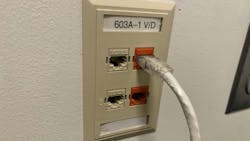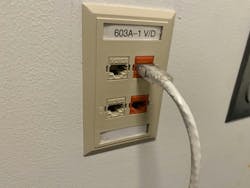Practically Speaking: Breaking Down Communications Outlet Requirements
Before 2008, communications outlets were not required to be installed in dwelling units. However, a proposal was submitted for the 2008 Code to require a minimum of two communications outlets for newly constructed dwelling units. NEC Code Making Panel 16 accepted this proposal in principle with new Sec. 800.156. It stated: “For new construction, a minimum of one communications outlet shall be installed within the dwelling and cabled to the service provider demarcation point.”
Part of the substantiation for this revision included the ability of the dwelling unit occupants to be able to make a simple call to emergency services such as police, fire, ambulance, or rescue squad. It is certainly hard to argue against that logic, but keep in mind that this proposal was submitted before smart phones became mainstream. The iPhone was released in 2007 and Android phones in 2008. This new cell phone technology revolutionized the way we communicate, and landlines started to be needed less and less. The 2011 Code was revised to require the communications outlet to be installed in a “readily accessible area.” For 2023, the requirement for a communications outlet is the same as it was in 2011, with the only difference being a change in the Code section from Sec. 800.156 to the newly created Sec. 805.156.
Now, here comes the weird part. Nobody knows what a “communications outlet” is. I could tell you what I think it is, but I would just be making up stuff. There is no definition for “communications outlet” in the Code. There isn’t one now, and there never has been. So, what is a “communications outlet”? A phone jack? A Cat. 6 port? A CATV connection? A local antenna connection? None of these? Any of these? Could a communications outlet be a 125V, 15A receptacle with powerline communications modems plugged in? Honestly, your guess is as good as mine. The literal wording in Sec. 805.156 requires cables to be installed to the service provider demarcation point. How do we satisfy this requirement if the dwelling is located where there are no communications service providers such as in a remote location high in the mountains or deep in the woods? Between cell phones, satellite phones, power line communication, and other wireless technologies, perhaps it may be time to revisit this requirement to see if it is still relevant for today and going forward. In the meantime, I’ll be using my iPhone to make phone calls, send text messages, pay bills, and stream movies directly to my smart TV without any hardwired communications circuits.
About the Author

Russ LeBlanc
Owner
Russ started in the electrical trade as an apprentice in 1985. He worked his way up to become a Journeyman Electrician and then eventually became a Master Electrician and Licensed Construction Supervisor. In 1999 Russ become an Electrical Instructor for The Peterson School of Engineering in Massachusetts where he developed his passion for teaching, and quickly became Department Head of Electrical Instruction. Russ has taught thousands of apprentices, electricians, engineers, inspectors, and other electrical professionals during his career as an instructor. He continues to provide electrical professionals with Electrical Code seminars, Arc-Flash Awareness training seminars and educational material through his LeBlanc Consulting Services in North Reading, MA whose specialty is educating electricians. He has been an active member of the NFPA Electrical Section and has authored hundreds of National Electrical Code proposals and comments which have become Code rules to improve the safety for the electrical industry. Russ is also an IAEI certified Electrical Inspector.
Please visit www.russleblanc.net for more information.

